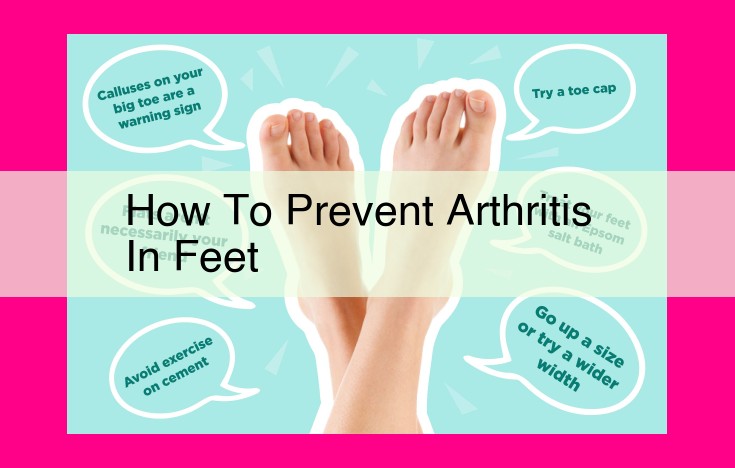Optimize Arthritis Prevention For Healthy Feet: Lifestyle Changes, Medical Interventions, And Custom Support

Prevent arthritis in feet by making lifestyle modifications, such as maintaining a healthy weight and exercising regularly. Choose supportive footwear with good cushioning and arch support, and take breaks to rest your feet. Consider medical interventions like anti-inflammatory medications and foot check-ups. Manage foot deformities and provide additional support with custom orthotics.
Preventative Measures for Arthritis in Feet: Lifestyle Modifications
Arthritis, an inflammatory joint condition, can cause pain, stiffness, and swelling in various body parts, including the feet. While there’s no cure for arthritis, certain lifestyle modifications can help prevent or slow its progression.
Maintain a Healthy Weight
Excess weight puts additional stress on the joints, including those in the feet. Shedding even a few pounds can significantly reduce pressure on these joints, alleviating pain and inflammation. Maintaining a healthy weight can be achieved through a combination of a balanced diet and regular exercise.
Engage in Regular Physical Activity
Exercise is crucial for overall health, including foot health. Strengthening the muscles surrounding the joints can provide support and stability. Additionally, improving flexibility through activities like yoga or stretching can increase the range of motion and reduce stiffness. Aim for at least 30 minutes of moderate-intensity exercise most days of the week.
Preventative Measures for Arthritis in Feet: Footwear and Rest
Introduction:
Arthritis in the feet is a common and painful condition that can significantly impact daily life. While there is no cure, there are several preventive measures you can take to alleviate discomfort and slow down its progression. In this blog post, we’ll explore the importance of footwear and rest in managing arthritis in the feet.
Choosing Supportive Footwear:
- Cushioning: Good cushioning can absorb shock and reduce stress on your joints, providing comfort while walking or standing.
- Arch support: Footwear with arch support helps distribute weight evenly, preventing excessive pressure on any one area of the foot.
- Wide toe box: Allowing your toes to spread out naturally reduces friction and pressure on bunions and hammertoes.
- Low heels: High heels can put unnecessary strain on the feet and ankles, exacerbating arthritis symptoms.
Taking Breaks Throughout the Day:
- Regular breaks: Give your feet regular breaks throughout the day to rest and recover.
- Elevate your feet: Elevating your feet improves circulation and reduces swelling.
- Foot exercises: Simple foot exercises can help strengthen muscles and improve flexibility, reducing pain and stiffness.
Conclusion:
By choosing supportive footwear and taking regular breaks, you can significantly reduce the impact of arthritis on your feet. Remember, prevention is key in managing this condition. By following these simple tips, you can improve your foot health and maintain an active and comfortable lifestyle.
Medical Interventions for Preventing Arthritis in Feet
Taking proactive measures to manage foot health can significantly reduce the risk of developing arthritis. Medical interventions play a crucial role in alleviating pain and inflammation, preventing further joint damage.
One common medication used to treat arthritis is anti-inflammatory drugs. These medications, such as ibuprofen and naproxen, help to reduce pain and swelling by blocking the production of inflammatory chemicals in the body. In severe cases, stronger anti-inflammatory medications may be prescribed.
Cortisone injections offer short-term pain relief by directly injecting corticosteroids into the affected joint. Cortisone acts as a powerful anti-inflammatory agent, providing temporary relief from pain and stiffness. However, it’s important to note that cortisone injections should only be used sparingly to avoid potential side effects.
Regular foot check-ups with a podiatrist are essential for early detection and management of foot problems that can contribute to arthritis. A podiatrist can assess the foot for deformities, such as bunions or hammertoes, which can put excessive pressure on the joints. They can also provide guidance on proper footwear and recommend custom orthotics to provide additional support and cushioning.
Joint Support for Preventive Foot Arthritis Care
Managing Foot Deformities
Addressing foot deformities like bunions and hammertoes is crucial for preventing arthritis. Bunions, bony bumps on the big toe joint, can alter the foot’s natural alignment, leading to pain and inflammation. Hammertoes, where the toe bends abnormally, can also cause discomfort and pressure on the joints. Early intervention is key to prevent these deformities from progressing and contributing to arthritis.
Various options are available for managing foot deformities. Non-surgical interventions include custom orthotics that provide additional support and cushioning, reducing pressure on the affected joints. Surgical procedures, such as bunionectomy or hammertoe correction, may be necessary in severe cases to realign the bones and alleviate pain.
Custom Orthotics for Enhanced Support
Custom orthotics are specially designed insoles that provide tailored support for individual foot needs. They effectively distribute weight evenly across the foot, reducing stress on specific areas that are prone to arthritis. Orthotics can also correct biomechanical imbalances, improving foot function and preventing further joint damage.
By incorporating these joint support measures into your preventive foot care routine, you can minimize the risk of developing arthritis in your feet and maintain optimal foot health for the long term. Remember, early detection and intervention are key to preserving joint function and preventing pain associated with arthritis. Consult a podiatrist for regular foot check-ups and expert advice on the best preventive measures for your specific needs.